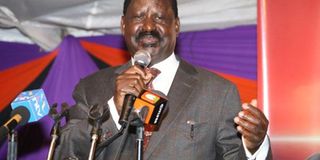Inside the Opposition’s strategy for 2017 elections

Cord leader Raila Odinga speaks at the Jaramogi Odinga Foundation in Nairobi during the launch of an SMS platform on May 14, 2015 to engage Kenyans, send news and party updates. PHOTO | BILLY MUTAI |
What you need to know:
- Raila is banking everything on the referendum.
- While President Kenyatta has appointed Nzioka Waita to head the Presidential Delivery Unit and ensure that Jubilee’s promises to Kenyans are met, his Government is balancing its development model with some real politik and making forays into Western Kenya and other perceived swing areas.
- In 2017, Raila plans to ride the wave of discontent that ODM/Cord anticipates against the Jubilee Government.
Commenting on the centrality of strategy in warfare, the renowned Chinese philosopher, Sun Tzu, observed that: “If you know the enemy and know yourself, you need not fear the results of a hundred battles”.
Kenya is, inexorably, slipping into an electoral frenzy. The best sign that the horse has bolted for Kenya’s 2017 presidential election was the launch of Cord’s Constitution of Kenya 2010 (Amendment) Bill on April 23, 2015 under the banner of Okoa Kenya.
The Bill is the kernel of ODM/Cord’s 2017 electoral strategy and a perfect dry-run for the race to State House. Cord is ostensibly beating the referendum drums to lure the Jubilee Government to abandon its ambitious developmental promises and embark on the campaign trail with nothing to show for its five years in office.
While President Kenyatta has appointed Nzioka Waita to head the Presidential Delivery Unit and ensure that Jubilee’s promises to Kenyans are met, his Government is balancing its development model with some real politik and making forays into Western Kenya and other perceived swing areas.
It was the French monarch, Louis XIV (1638 –1715), who once boasted that: L’Etat, c’est moi (“I am the State”). Today, Raila Odinga is the Opposition in Kenya. Whatever the outcome of 2017, Raila is poised to influence the country’s politics long into the future.
Critics such as Raila’s former aide Miguna Miguna, whose Peeling Back the Mask became a bestseller, depict the Opposition chief as a man of many vices and contradictions. But Raila’s strategists have succeeded in winning the world to the perception that he is a paragon of virtue, justice, rule of law, democratic reforms and all that is good for Kenya — an enviable position for any presidential hopeful.
But what is the source of Raila’s power? His most formidable asset is his enormous political capacity to think and plan for power in a modern, systematic way. For him, structures like NDP, LDP, NARC, ODM, CORD and now OKOA Kenya are mere vehicles of the ideas generated by his complex and multi-layered think-tank.
His capacity to think and plan for politics and to saturate the marketplace with his ideas — however revolting — has enabled Raila to dominate his co-principals in Cord (Kalonzo Musyoka and Moses Wetang’ula) and to put Jubilee troops on the defensive.
Despite this, in the run-up to 2017, Raila is paying the price for not heeding Master Sun’s wise counsel: “Regard your soldiers as your children, and they will follow you into the deepest valleys; look on them as your own beloved sons, and they will stand by you even unto death.”
His inability to keep strong allies, forge enduring alliances and friendships or to think outside the prism of power is exacting a heavy toll on his power ambition.
Since the formation of ODM in 2005, it has peeled away like a decaying onion. Now, with Mwai Kibaki and his men out of power, 2017 is, literally and paradoxically, a do-or-die battle between Raila and ODM!
Jubilee Government is made up of ODM leaders who either left before the 2007 election such as Uhuru Kenyatta or bolted away from the formidable ODM Pentagon after 2007 (William Ruto, Musalia Mudavadi, Charity Ngilu, Najib Balala).
The exception is Kalonzo Musyoka, who bolted from ODM to his own Wiper Democratic Movement (WDM), but rejoined Raila as a co-principal in Cord in 2013. But, as in other cases, Cord is no longer the tie that binds Raila and his 2013 allies, and it is not crystal clear that Kalonzo and Wetang’ula will be with him to the end.
Although Raila’s 2017 game plan is to recapture the 2002 “NARC Moment” and form a kind of summit that brings together regional leaders, his catchment areas for regional heavyweights has dwindled.
Despite Raila’s acclaimed capacity for political thinking, he attributes his loss of the 2013 presidential contest to Uhuru Kenyatta and William Ruto to “a disjointed campaign”.
But Odinga’s 2017 campaign is even faultier. As Opposition leader since April 2013, Raila has been surfing the waves of the problems that the Jubilee administration has faced in implementing the new constitution particularly devolution, fighting corruption and the threat of terrorism and asymmetric conflicts relating to clan/ethnic feuds and cattle rustling in the north.
GRIEVANCES
In 2017, Raila plans to ride the wave of discontent that ODM/Cord anticipates against the Jubilee Government. As a result, his campaign has no gifts but grievances.
Raila is banking everything on the referendum. However, the trouble with Okoa Kenya’s referendum Bill is that it is a basket of grievances, mainly about failures of past regimes and the Jubilee administration in regard to the land question, security, inclusivity in government appointments and electoral reforms to counter the “tyranny of numbers”.
Missing in the equation is a forward-looking agenda reflecting the dreams of young Kenyans or Africans as envisioned in Kenya Vision 2030 or Africa’s Agenda 2063 on pan-Africanism and Renaissance.
While elections in the 1992-2013 decades have been about “grievances,” Cord must realise that 2017 will be won on the platform of development “dividends,” not old “grudges” or “grievances”.
Prof Kagwanja is chief executive, Africa Policy Institute, and former government adviser [email protected]





